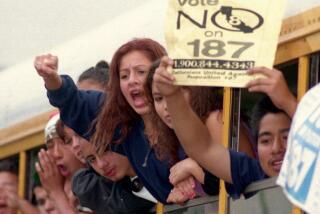The electorate’s changing face
- Share via
The Latino Wave
How Hispanics Will Elect
the Next American President
Jorge Ramos
Translated from the Spanish
by Ezra E. Fitz
Rayo: 260 pp., $24.95
*
All Americans ought to read this book -- or at least know what it says. It is about the future of the United States.
The central message in Jorge Ramos’ “The Latino Wave” is not exactly what its subtitle says, that Hispanics will elect the next American president. It may or may not turn out that way.
The book’s principal theme is a statement of an obvious fact, that Latinos -- entering the United States from Mexico, Central America, South America, Cuba, Puerto Rico, the Dominican Republic -- are rapidly growing in numbers. The numbers will soon be followed by an increase in influence.
Exactly how? Ramos has some ideas. The most obvious is political power, though he confesses he cannot foresee the course it will take.
Ramos’ views are widely known among Latinos in the United States. He is a popular and respected news anchorman for Univision, the country’s largest Spanish-language television network.
He has all the virtues of a fluent, handsome anchorman. Not an expert himself, he knows where to find them. Not especially subtle, he is clear and forceful.
The import of his message has been known to Latinos and some observant non-Latinos for three or four decades. It is only now, with Latinos the largest ethnic minority in California and elsewhere in the Southwest and growing in numbers throughout the U.S. that the rest of the country is beginning to notice.
Some academics and a few politicians are viewing the trend with alarm, arguing that the nature of the United States will change. That reaction is nothing new. It has occurred since the original settlers of the Eastern Seaboard from the British Isles were joined by others, such as the Germans in Pennsylvania. Suspicion of newcomers has existed as long as the country has, only to be assuaged by time, assimilation and acceptance of the fact that this nation has never really been static.
Its hallmarks are change and constant motion, not stability of populations. The isolation, cohesiveness and ethnic conservatism of discrete populations like the descendants of the original Spanish settlers in northern New Mexico are not the rule but the rare exception.
Ramos opens his book with a tough look at the 2000 election. George W. Bush understood the importance of Latino voters, he says; Al Gore did not. Bush spent a lot of time and money courting this part of the electorate in person and in network advertising; Gore didn’t. But Ramos is no partisan. He argues that despite the importance of the anti-Castro Cuban American vote in Florida, the Republicans cannot take for granted that edge among Hispanic voters.
Sometimes Ramos’ assertions are so sweeping as to be vague and overblown. “We are everywhere, and there is no occupation or activity in this country that escapes our influence,” he writes. “This century is ours.”
But more quietly Ramos also writes that “the United States is becoming an ever more multiethnic, multicultural and multiracial country, one where labeling an increasingly diverse population will be an increasingly difficult -- and sometimes ultimately futile -- task.”
Ramos quotes New Mexico Gov. Bill Richardson, the son of a Mexican mother, as saying that the confident prediction of Ramos’s subtitle -- that Latinos “will” elect the next president -- should instead be taken as a challenge to Americans of Spanish-language origins.
“Our vote will prove decisive in this election,” he quotes Richardson as saying, “because of the presence we have in states like Florida, New Mexico, Arizona, Colorado, Illinois, California, Nevada, New Jersey and New York.”
And Ramos then quotes Richardson’s cautionary challenge: “If we don’t register and we don’t participate, the two parties aren’t going to pay any attention to us.”
More to Read
Sign up for Essential California
The most important California stories and recommendations in your inbox every morning.
You may occasionally receive promotional content from the Los Angeles Times.










